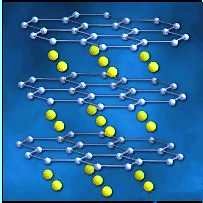

MgB2 Theory Confirmed
Physicists in Japan and the US have confirmed that magnesium diboride contains two superconducting energy gaps. Although theorists had predicted that the material had two gaps, they had never been observed in an experiment. The gaps are thought to be responsible for the relatively high superconducting transition temperature of 39 K observed in the material (S Souma et al. 2003 Nature 423 65).
Magnesium diboride consists of hexagonal planes of boron atoms separated by planes of magnesium atoms, with the magnesium centred above and below the boron hexagons (see figure). This structure is very similar to that of graphite: each carbon atom - which has four valence electrons - is bonded to three others and occupies all planar bonding states (the sigma bands). The remaining electron moves in orbitals above and below the plane to form pi bands. Boron atoms have fewer valence electrons than carbon so not all of the sigma bands are occupied. This means that lattice vibrations in the planes are much larger, which results in the formation of strong electron pairs.
Most superconductors have only one energy gap but in 2002, theorists predicted magnesium diboride might have more than one. These gaps develop simultaneously at the superconducting transition temperature, Tc. Now, Takashi Takahashi from Tohoku University and colleagues have used high-resolution photoemission spectroscopy (ARPES) to directly observe the two gaps by resolving the sigma and pi bands.
Tahakashi and co-workers measured ARPES spectra at two temperatures below and above Tc (17 K and 45 K). They found that the sigma bands have a large gap of 6-7 meV, whereas the pi band has a smaller gap of 1-2 meV. These results agree with previous reports. As the superconductivity of magnesium diboride is bulk in nature, the researchers conclude that the sigma band is dominant.
NOTE: Industrial prospects for Magnesium Diboride
appear now to be more encouraging following the demonstration
that introducing internal structural defects can improve its
performance in practical applications such as hospital Magnetic
Resonance Imaging (MRI) scanners. In superconductors the ability to carry
current without dissipation is enhanced if the material contains
impurities or defects of suitable characteristics in order to "pin" the
magnetic flux. Recent studies of magnesium-diboride thin films by Bracinni,
et al, found Hc2 > 50T when the boron sites in MgB2 were doped with carbon. An increase
in Jc to 106 A/cm2 at 10 K was realized when MgB2 was doped with SiC, YB4, TiB2 or MgSi2.
 For the original Berkeley Labs article, click here
For the original Berkeley Labs article, click here
 Helpful Link: Magnesium DiBoride at UW-Madison
Helpful Link: Magnesium DiBoride at UW-Madison
 BACK to the "Type2" page at Superconductors.ORG
BACK to the "Type2" page at Superconductors.ORG
 BACK to the "News" page at Superconductors.ORG
BACK to the "News" page at Superconductors.ORG